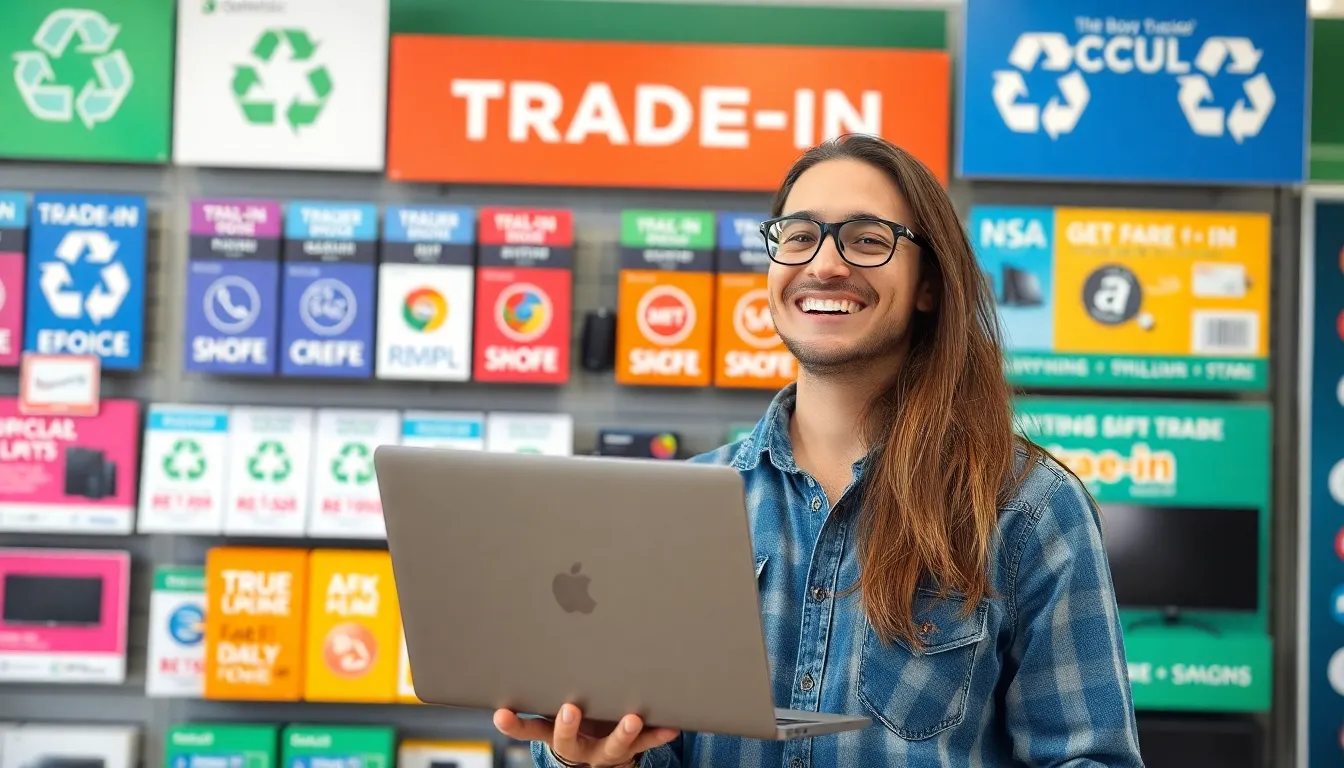In today’s fast-paced tech landscape, upgrading to the latest laptop often feels like a necessity. With constant advancements in performance and features, many users find themselves grappling with the question of what to do with their old devices. Enter laptop trade-in programs—an increasingly popular solution that offers a convenient way to recycle technology while also providing some financial relief for new purchases.
These programs not only help users declutter their lives but also promote sustainability by reducing electronic waste. By trading in an old laptop, individuals can receive credit towards a new device, making the transition smoother and more affordable. As more companies embrace this eco-friendly approach, understanding the ins and outs of laptop trade-in programs becomes essential for savvy consumers looking to make informed decisions.
Table of Contents
ToggleOverview of Laptop Trade-In Programs
Laptop trade-in programs allow users to exchange old laptops for credit toward new purchases, simplifying the upgrade process. Most major retailers and manufacturers, including Apple, Best Buy, and Amazon, offer these programs, making participation accessible.
Participants can expect to receive varying amounts of trade-in value based on device age, condition, and specifications. Typically, laptops in excellent condition yield higher credit amounts. Trade-in values can range from $50 to over $500, depending on the model and year.
The process for participating in a trade-in program is generally straightforward. Users need to evaluate their laptop’s condition, provide necessary information, and obtain a quote. After acceptance, users can ship their laptops at no cost or visit a designated store. Upon assessment, trade-in credit gets applied to future purchases.
Trade-in programs often adhere to specific guidelines, including data wiping standards to ensure personal information security. Many companies promote sustainability by highlighting their commitment to recycling and refurbishing used devices, further encouraging participation.
Users considering a laptop trade-in should compare offers from various programs to maximize their trade-in value. Familiarity with program terms and conditions helps ensure a seamless experience.
Benefits of Participating in Laptop Trade-In Programs


Participating in laptop trade-in programs offers significant advantages, particularly in terms of environmental benefits and financial savings. These programs facilitate responsible device disposal while providing monetary incentives for users.
Environmental Impact
Laptop trade-in programs play a crucial role in reducing electronic waste. By recycling and refurbishing old devices, these initiatives minimize landfill contributions, promoting a greener planet. Companies often adhere to strict environmental standards, ensuring materials are processed sustainably. Engaging in a trade-in program effectively supports responsible consumption and helps preserve natural resources through the recovery of valuable components.
Financial Savings
Financial savings represent a key benefit of laptop trade-in programs. Users can receive trade-in values between $50 to over $500, depending on device condition and specifications. By applying this credit towards a new purchase, individuals significantly lower the cost of their upgrade. Many retailers offer competitive quotes, so comparing multiple trade-in offers can maximize potential returns. This structured approach to upgrading devices not only enhances affordability but also simplifies financial planning for future technology investments.
How Laptop Trade-In Programs Work
Laptop trade-in programs offer a streamlined process for users to exchange old devices for credit towards new purchases. These programs encourage environmental sustainability while making device upgrades more affordable.
Assessment of Device Value
Determining the trade-in value requires users to evaluate several factors related to their devices. Companies typically assess:
- Age: Newer laptops generally receive higher trade-in values.
- Condition: Functional laptops in good physical condition earn better quotes than damaged ones.
- Specifications: Device specifications, such as processor type and storage capacity, impact valuation.
Retailers provide online tools for users to input these details, generating instant quotes that reflect current market demand.
Process of Trade-In
The trade-in process consists of a few straightforward steps:
- Evaluation: Users evaluate their device’s condition, age, and specifications.
- Quote Retrieval: Users access online platforms or retail locations to receive a quote.
- Device Submission: Users either ship their laptops or bring them to a store for final evaluation.
Upon approval, users receive credit that directly applies to their new purchase, making the transition to updated technology both efficient and cost-effective.
Popular Laptop Trade-In Programs
Several well-known laptop trade-in programs offer users an opportunity to exchange their old devices for credit towards new purchases. Key players like Apple, Best Buy, and Amazon provide varied options to meet customer needs and facilitate seamless upgrades.
Program Comparisons
| Program | Estimated Trade-In Value | Process | Additional Benefits |
|---|---|---|---|
| Apple | $100 – $500+ | Online evaluation, in-store drop-off | Credit for future purchases, Apple recycling program |
| Best Buy | $50 – $300+ | Online assessment, in-store drop-off | Rewards points on new purchases, easy upgrade path |
| Amazon | $25 – $400+ | Online quote, mail-in shipping | Store credit, wide range of products |
| Dell | $50 – $600+ | Online evaluation, free shipping | Discounts on new Dell products, environmentally focused |
Comparisons reveal differences in trade-in values, processes, and additional benefits. Apple tends to offer higher trade-in values for newer models, while Best Buy provides rewards points for future purchases. Amazon allows users to mail in devices and receive store credit. Dell’s program includes environmentally friendly initiatives, appealing to eco-conscious customers.
User Reviews and Experiences
Users consistently report positive experiences with laptop trade-in programs, praising the convenience and efficiency of the processes. Some common themes in user reviews include:
- Ease of Use: Many users appreciate straightforward online evaluation tools that provide instant quotes.
- Fast Transactions: Individuals often highlight quick processing times for credits, whether receiving them electronically or in-store.
- Customer Support: Positive feedback often mentions responsive customer service available for inquiries and issues during the trade-in process.
Overall, user reviews indicate that these programs simplify upgrading and provide satisfactory financial benefits, enhancing the overall experience of transitioning to new technology.
Considerations Before Trading In Your Laptop
Understanding key considerations enhances the trade-in experience. Here’s what to keep in mind:
- Condition Assessment: Examine the laptop’s physical and functional state. Minor wear affects trade-in value but may not significantly lower it; extensive damage likely decreases value.
- Data Security: Ensure complete data removal to protect personal information. Use factory reset options to wipe all data. Verify the company’s commitment to data destruction before proceeding.
- Research Programs: Compare trade-in programs from various retailers and manufacturers. Differences in trade-in values and processes exist, often impacting overall savings. Look for deals and promotions for additional benefits.
- Timing of Trade-In: Consider the laptop’s age and upcoming releases. Newer models typically fetch higher trade-in values. Analyze the optimal time to trade based on product cycles.
- Documentation Availability: Keep original packaging, receipts, and warranties. Providing documentation may enhance the trade-in value and streamline processing.
- Understanding Terms and Conditions: Familiarize with the specific terms of the trade-in program. Details regarding eligibility, offers, and refund policies often impact the transaction.
- Shipping vs. In-Store Options: Identify whether the program offers convenience through shipping or requires in-store visits. Choose what best suits individual circumstances and preferences.
- Value of Accessories: Assess bundled accessories, such as chargers and cases, that could influence trade-in value. Some programs consider these when determining the final quote.
By addressing these considerations, users maximize their benefits and enhance their overall trade-in experience.




